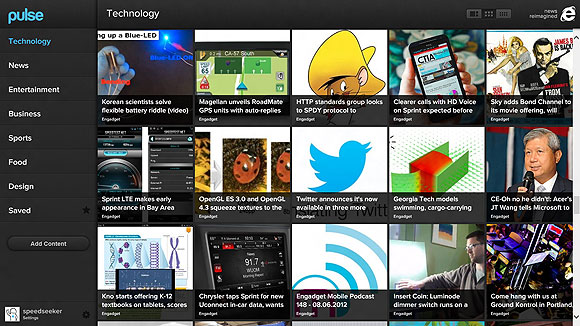REDMOND, Wash. — Aug. 9, 2012 — A few years ago, two graduate engineering students were faced with an interesting challenge posed by a class at Stanford University: Build a product and launch it in 10 weeks.
Focused on the task at hand, Akshay Kothari and Ankit Gupta didn’t realize they were actually launching their careers. Together, they created Pulse, an elegant news reading application originally designed for mobile devices, and now available on the Web. Pulse incorporates colorful panning story bars and fills them with content from sources you select.
“Suddenly, our small class project became a company,” Kothari says.
Today more than 15 million people around the world use the Pulse app on every major mobile platform, including Windows Phone. The app has grown to offer content from virtually every major U.S. publisher and a growing list of international ones. Its visual style and simple navigation have garnered praise from consumers and the press alike, and it has earned numerous awards for its design.
According to Kothari, the success of the app has everything to do with good design that puts content front and center, making it easy for people to find what they’re looking for.
“We wanted something that was very visual and engaging,” Kothari says. “We didn’t want reading the news to feel like a chore, but rather something that you want to do. So the Pulse design on the mobile apps has really resonated with people.”

August 08, 2012
Pulse keeps you up to date with all your favorite news sites and blogs.
This week the company is announcing the next step in its evolution — moving to the Web. Pulse worked in conjunction with the developers at Pixel Lab and the Windows Internet Explorer team to completely redesign Pulse into a visually stunning new Web service using HTML5. It’s a new experience for the Web that Gupta and Kothari say will shine in Microsoft’s new Internet Explorer 10 browser through its extensive use of fast and fluid multitouch support.
“We’re excited to take on the next frontier, which also happens to be our most requested feature — the Web,” says Kothari. “Playing with Internet Explorer 10, we were amazed by the fluidity of it, and that inspired us to create an experience on the Web that, in some aspects, will be even more beautiful and intuitive than our mobile apps. It’s very fluid, very fast. And what you can do with Internet Explorer 10 and touch on the Web will surprise a lot of people.”
But taking a mobile app to the Web isn’t as easy as just porting it to a new platform. It’s an entirely different computing paradigm that Pulse had to examine from top to bottom.
“People are on their phone for two to three minutes, snacking on news throughout the day,” Gupta says. “On the tablet at home after work, they’re sitting on the couch and having a longer session, 15 to 20 minutes. Now moving to the Web, it’s always open, connected, and we had to find a way to keep stories refreshed and remind you of new stories that are breaking.”
To live up to the high bar set by its mobile apps, Pulse had to rethink the experience of using the application on a computer versus swiping and scrolling on a phone. The service will support impressive touch gestures with Internet Explorer 10 on a touch device running Windows 8 Release Preview and, of course, will also work for those using a mouse and keyboard.
“There are things we can do with gestures on the smaller screen and the touch affordance that we can’t do on the Web,” says Gupta. “Pinching, panning, zooming in and out, tapping — we had to examine all these gestures and come up with ways to let users control those actions.”
One big challenge: horizontal scrolling. The Pulse mobile app works on two axes, which on a phone is as natural as swiping a finger one way or the other, but on the Web, not so much. The solution? A striking new layout that combines collections without the need to scroll side to side.
“We had to get rid of the horizontal axis and focus on the vertical,” Gupta says. “With our new design for the home page, all of the stories in the collection are combined and arranged in a beautiful layout that extends from edge to edge.”
Apart from the striking new design, both men say the company’s biggest concern was to deliver speed and performance on the Web that rivals native applications running on portable devices. Internet Explorer 10 allowed them to do that with HTML5 and advanced touch support coupled with hardware acceleration enabled through Windows. The result, they say, is something that may just change the way people think about building applications for the Web.
“The team at Internet Explorer 10 and Pixel Lab really helped us perfect the design and performance, particularly in Windows tablets,” says Gupta. “It’s not just a vision of what HTML5 can do, but it’s actually happening today with the modern browsers like Internet Explorer 10. We are really excited to launch this now and blow people away.”
Try Pulse
With
Internet Explorer 10 Today
Pulse for the Web is available today at http://www.pulse.me. Web enthusiasts who would like to try it out with Internet Explorer 10 can download the Windows 8 Release Preview. Windows 8 with Internet Explorer 10 is scheduled to be commercially available in stores Oct. 26.




